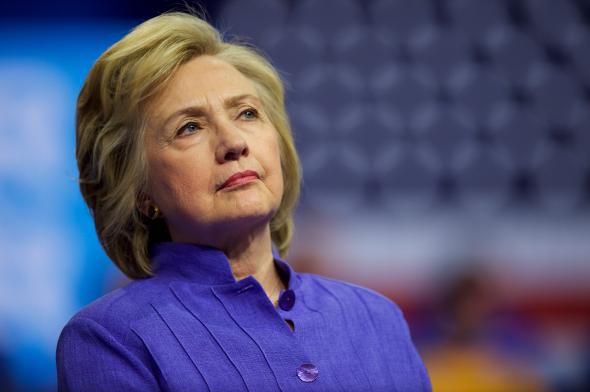The polls—so many polls. They will just keep coming between now and Election Day, making it easy to forget the golden rule of polling: Don’t get distracted by a single survey. With that in mind, Slate will be checking in once a week to see what’s changed—and what hasn’t—in the 2016 presidential polls.
Where Do the Polls Stand Today?
Donald Trump is closing in on Hillary Clinton—and even passed her in one recent overhyped national poll—but the Democratic nominee remains the clear leader in the national averages, which offer a far better snapshot of the race than any single survey can.
RealClearPolitics:
- Head-to-head: Clinton +3.0 points (Clinton 45.9 percent, Trump 42.9 percent)
- Four-way race: Clinton +2.1 points (Clinton 41.3, Trump 39.2, Gary Johnson 8.4, Jill Stein 3.2)
Huffington Post:
- Head-to-head: Clinton +5.3 points (Clinton 46.5 percent, Trump 41.2 percent)
- Three-way race: Clinton +4.3 points (Clinton 42.0, Trump 37.7, Johnson 8.9, other 4.1)
Depending on which average you prefer, Clinton’s lead has fallen by as much 2.1 points (RCP’s four-way) or as little as a single tenth of a point (HuffPo’s head-to-head) in the past week. Those aren’t seismic changes, but they were enough to decrease her projected odds of winning the White House according to the moneyball crowd. Nate Silver’s FiveThirtyEight now gives Clinton a roughly 68 percent chance of victory in its polls-only forecast, down about 6 points from last week and down more than 20 from her all-time high in that model, which she hit in mid-August. Silver’s projections, however, are among the more pessimistic when it comes to avoiding the Trump-ocalypse. The New York Times’ Upshot gives Hillary an 83 percent chance of victory while the Princeton Election Consortium pegs her odds at 93 percent.
Why Are the Polls Tightening?
For starters: Things realistically couldn’t have gotten much worse for Trump than they were a few weeks ago, and so it’s not a shock that they instead have gotten a little better of late. This time last month, the GOP nominee was in the middle of a post-convention controversy tour that careened from insulting the parents of a fallen U.S. soldier to suggesting President Obama “founded” ISIS and beyond. More recently, though, he’s avoided veering too far from his intentionally muddled message, which appears to have convinced some skeptical conservatives that it might not be the worst idea in the world to vote for him. At the same time, Clinton went largely MIA from the campaign trail to instead fundraise behind closed doors. Toss in a rough news cycle or two concerning the Clinton Foundation, and Hillary’s numbers have slipped from where they were immediately after the Democratic convention.
Some of the recent volatility may also be explained by the reality that Americans tend to start paying more attention to the presidential race after Labor Day, so many are only weighing their options seriously for the first time now. And then there’s this: Pollsters are beginning to shift their attention from registered voters to those they believe are likely to vote. Different pollsters make different assumptions about who will show up on Election Day and, as a result, weight their responses accordingly. Consider this week’s CNN/ORC poll that showed Trump with a two-point lead over Clinton in a four-way race: Working with the same raw data and different assumptions about the turnout of white Americans without a college degree, NBC News says it would have looked at the same responses CNN collected and instead concluded it was a four-point race—in Clinton’s favor.
How Should Trump Supporters Feel Today?
Pretty darn relieved, for now. Trump still has a long way to go to catch Clinton, but the latest polling suggests he’s at least heading in the right direction. And the longer he keeps it close, the more difficult it will be for the Republican Party to cut him adrift to focus its resources on down-ballot House and Senate races. Still, Trump’s bigger-picture problems remain: It’s unclear whether his ceiling is high enough to win unless third-party candidates disproportionately siphon off votes from Clinton, and he has far fewer paths to winning the Electoral College than does his Democratic rival.
How Should Clinton Supporters Feel Today?
Good, but not great. A few weeks ago, Trump’s campaign was in shambles and it appeared possible that Clinton might win the White House in a landslide. While that’s still possible, the current polls suggest that the polarization of the electorate—coupled with Americans’ not-unrelated intense dislike of both candidates—will mean a final outcome that looks like a relatively run-of-the-mill election. Clinton’s currently up by about three or four points in national polls; Obama beat Romney by roughly four points in 2012. If you’re a Hillary fan, then, you’re nervous Trump has made up ground and perhaps disappointed Clinton hasn’t run a stronger campaign—but you’re still in a better position than fans of her opponent.
What Are the States to Watch?
Reliable polling at the state level is still a little hard to come by at the moment, which means you’re better off looking at the bigger picture for now. But if you are going to focus anywhere, your best bets are probably Florida and Pennsylvania. Winning the former represents one of the simpler paths to the White House for Clinton. If she wins the 19 states (plus the District of Columbia) that have voted for the Democratic nominee in each of the past six presidential elections, she’d be able to clinch the election simply by adding the Sunshine State’s 29 electoral votes to that haul. For Trump, meanwhile, winning Pennsylvania appears to be a necessity barring some sort of surprise elsewhere. Right now, both states offer good news for Clinton: She’s up roughly two or three points in Florida, and up about six or seven points in Pennsylvania. Those numbers will likely rise and fall along with the national numbers in the weeks to come.
